Counties in Time
Published in Features, Issue 1 (Spring 2004), Volume 12The National Archives of Ireland has produced a CD-rom, Counties in time, containing almost a thousand documents selected from its holdings. Eneclann, a historical research company, was contracted to select and prepare content, while Lendac Data Systems produced the CD.
The records chosen exist, in nearly all cases, for the 32 counties of Ireland, and cover the period from the late sixteenth century to the mid-twentieth century. The National Archives is used extensively by local and family historians from all over the country and from abroad, as well as by political, economic, social and administrative historians. Local history is a growing area of interest for many people, and it is hoped that Counties in time will alert them, and many others, to the rich archival heritage preserved in the National Archives.
The county structure
There are many reasons for choosing a county structure for a publication of this sort. Counties are long-standing administrative and political units with clearly defined geographical borders. But they also reflect much older divisions. For example, modern County Longford is almost identical to the medieval Gaelic lordship of Annaly, long controlled by the O’Farrells. Similarly County Kerry represents the amalgamation of the Anglo-Norman ‘liberty’ of Kerry in the north and the MacCarthy Mór kingdom of Desmond in the south. There have been strong local allegiances in Ireland for centuries, long before the establishment of an island-wide government under English control.
Over the course of the last 400 years this local identity has not fundamentally changed. In fact, it has arguably become even more pronounced, considering the strength of local support for county-based GAA and other sporting events, as well as strong local political allegiances. As a consequence, there is a well-developed county consciousness in Ireland, both north and south.
The documents
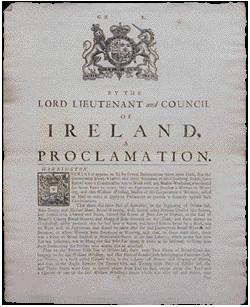
Proclamation regarding workers in the clothing trade, 1747 Dublin, class 5.
The 31 classes of records chosen for Counties in time represent only a tiny fraction of the National Archives’ total holdings, but they are good examples of the types of information a user is likely to find in the Archives. Most surviving records from the past relate to the administration of economic and political authority, and this is particularly true of those in the National Archives, which is the official repository for all state records, as were its predecessor institutions, the Public Record Office of Ireland and the State Paper Office of Ireland. For this reason, most of the record classes highlighted by Counties in time are concerned with the administration of justice, security, taxation, education and other governmental activity. While these records were compiled for specific official purposes, they reveal a good deal about the experience of the general population in the past.
For example, despite the fact that the state-controlled Poor Law system and Relief Commission were incapable of dealing with the enormity of the Famine, the records they generated are essential for historians examining the impact of that disaster. While the Habeas Corpus Suspension Act abstracts and photographs of Fenian suspects were created to equip the state to deal with a perceived subversive threat, they now offer us unique insights into the membership of this clandestine organisation, including a visual record of some of its members.
Similarly, the census returns of 1901 and 1911 were collected to assess the number of people throughout the country, their religious composition, and other demographic details that ultimately formed the basis of statistical reports. Today these records are a prime resource for those tracing their ancestry. While researchers must be aware of the reasons for the original compilation of state records, they can be used to address a variety of different historical questions. This issue is covered at some length in the CD’s guide to using documents for historical research.
The National Archives’ records date from the medieval period, but do not constitute a national or island-wide body of records until the later sixteenth century, for two reasons: it was not until then that the government in Dublin exercised authority over most of the island; more importantly, most state records (particularly for the years before 1700) were lost in the destruction of the Public Record Office in Dublin in 1922. While this tragedy saw many priceless records consumed by fire, some did survive (for example the Chancery Pleadings, court records from the sixteenth and seventeenth centuries). Others have been acquired over the last 82 years in the ongoing attempt to fill the gaps created in 1922. The National Archives Act of 1986 has resulted in the transfer of large quantities of departmental records to the Archives, and an associated increase in interest in twentieth-century history.
Most of the collections included in this publication cover every Irish county. However, some classes of records only relate to the 26 counties of the Republic, and the northern material is now kept in the Public Record Office of Northern Ireland (Tithe Applotment Books, Petty Sessions records and Business Records). For two further classes of records, some material is held by the National Archives but the larger proportion is held in PRONI (e.g. National School Applications and Registers and Valuation Office Field and House Books).
The documents chosen cover many aspects of government activity over the last 400 years. For the early period, there are [numbered in the order in which they appear on the CD] the judicial records of the Court of Chancery [3] and the early nineteenth-century transcripts produced by the Irish Record Commission [4], dealing with several classes of records from the sixteenth and seventeenth centuries. For the later seventeenth century there are two classes of records concerned with what was arguably the most important issue of the day, land ownership: the Down Survey Baronial Maps [2] and the Books of Survey and Distribution [1].
For the eighteenth century, the National Archives holds a series of government Proclamations [5] dealing with many different issues, particularly the enforcement of the penal laws. The Rebellion Papers [6], which concern the tumultuous events before, during and after the 1798 Rebellion, have been widely used by researchers and historians.
During the nineteenth century government activity expanded, new national institutions were established and the quality of record-keeping was transformed. The quantity of state documents increased dramatically. Many of these records reflected two ongoing major concerns of the state: crime and security. Several classes of records included in Counties in time relate to these issues. From the early nineteenth century there are the Outrage Reports [9], which contain reports on crime, sent to Dublin Castle from around the country. Formal trial records include the lowest criminal court, the Court of Petty Sessions [18], which dealt with more mundane local illicit activities. More serious crimes were reported annually in the Returns of Outrages [10], and Counties in time contains examples from 1848 and 1862.
Many of those convicted were sentenced to transportation to Australia, and they are listed in the Transportation Registers [12]. These prisoners did have the opportunity to appeal their sentences, and the Convict Reference Files [13] include prisoners’ petitions and letters from relatives and attorneys on their behalf. The activities of political subversives were of serious concern to the government, and some of this is reflected in the Fenian photographs [28] and abstracted Habeas Corpus Suspension Act papers [27] concerning them in the 1860s and 1870s.
Another prominent issue for government was the assessment and collection of various taxes. This is reflected in the Tithe Applotment Books [11], which record the religious tax (or tithe) due to the Established Church during the 1820s and 1830s. During the 1840s and 1850s, the government employed a sizeable body of assessors to determine the basis for local taxation. These assessors compiled the Valuation Office Field and House Books [22], before publishing their final figures in the Primary Valuation [21] between 1848 and 1864. These taxes were intended for the upkeep of workhouses and other features of the Poor Law system. The full impact of the Famine stretched the system to breaking-point, and this is starkly evident from the Relief Commission papers [14], which provide details of the failure of the potato crop and local efforts to alleviate the disaster.
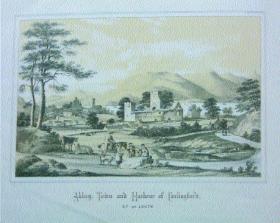
Engraving of Carlingford, Co. Louth, 1857 Landed Estates Court Rentals, class 23.
The government also established a range of new national institutions, many of which still operate today. These included the National Education system. The 1835 report of the Commissioners of Public Instruction [19], on the state of private and public educational bodies across the country, provides a snapshot of the situation before the full implementation of the state system. The later development of the system is reflected in examples from the National School Applications and Registers [20]. Other bodies were established, one of which fundamentally changed the physical landscape of the country: the Office of Public Works [25 & 26] is represented by colourful and detailed plans, which offer a unique insight into architectural and infrastructural concerns of the time. The early nineteenth century also witnessed the foundation of the first permanent body to oversee the mapping and naming of all parts of the country. Among the Ordnance Survey records can be found detailed Town Plans [8]. County maps extracted from Lewis’s Topographical Dictionary [7] of 1837 provide details of pre-Ordnance Survey Ireland.
The early stages of change in the modern ownership of land in Ireland are covered by the Landed Estates Court Rentals [23], which give details about the tenants and physical layout of several large estates sold under the auspices of this court, and sometimes contain picturesque engravings of houses. Throughout the century, private publishers produced local and national Trade and Street Directories [24], providing information about businesses in the towns of Ireland.
Most of the nineteenth-century census returns have been lost or destroyed, although the printed Reports contain a lot of invaluable statistical information (see the 1851 Census Reports [15]). However, the 1901 [16] and 1911 census returns [17] survive in full, and represent one of the most important historical and genealogical sources for the period.
The early twentieth-century history of the country was transformed by the establishment in 1919 of the first Dáil Éireann, which attempted to administer the country as an independent state. The Dáil Éireann papers [31] represent a key collection in the National Archives, covering a defining period in the country’s history. The new state’s attempts to administer internal security against real, potential and imagined threats during the 1930s and 1940s are well reflected in the Department of Justice files [30].
As well as meeting its responsibilities for government records, the National Archives also has custody of many private records. These include estate records, legal records, trade union records, hospital records, harbour records and many other collections. The Business Records Survey [29], established in 1970, has brought together over 1000 individual collections of business records, both large and small, from all over the country. The samples included in Counties in time reflect the great diversity of records acquired through the Survey.
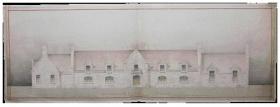
Proposed farm building, Athenry Agricultural College, Co. Galway, 1907 Office of Public Works, class 25.
The documents chosen from these classes for Counties in time were selected on the basis of several criteria. In most cases there are 31 examples corresponding to the 32 counties, allowing us to give a broad sample of the types of records and information each class contains. We have attempted to select records from across the span of years covered by each class, while also being generally representative of their content. In some cases this has not been practical or necessarily desirable. For example, the Outrage Reports are overwhelmingly concerned with minor acts of agrarian violence, like crop burnings, which rarely provide much local detail. While we have chosen many items that reflect these activities, we have tried to concentrate on reports where there is sufficient information to both engage and educate the reader.
Scanned images
Counties in time contains scanned images of all of the original documents for 25 of the record classes chosen, and sample scans for six classes. This enables the reader to view the documents on screen in full colour, and to experience at a distance the interest and complexity associated with using primary sources.
Transcripts
Full text transcripts of thirteen classes of records have also been provided. These can be used in conjunction with the scanned versions of the same documents to help decipher manuscript items. In some cases we have provided only transcripts (and sample scans) of the records chosen, either because the originals are particularly difficult to read (e.g. Chancery Pleadings) or because the original records follow a standard format and layout (e.g. National School Applications and Registers).
Class introductions
To facilitate the reader’s understanding of the documents chosen for Counties in time, introductions to each class of records have been provided. These deal with how the records came into existence, who compiled them, and what information they are likely to contain. The introductions also make illustrative reference to some of the documents chosen, give advice on how to use them, and alert the reader to any problems which may arise. Where possible, further reading has been recommended.
County histories
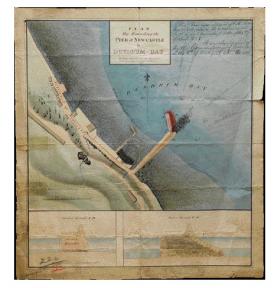
OPW plan of a pier at Newcastle, Co. Down, 1828 class 26.
Counties in time contains 32 county histories, covering the period from the late sixteenth century to the mid-twentieth century and ranging in length from 5000 to 7000 words. Each history contains 6–7 images, both photographic and pre-photographic, and each includes a bibliography to assist the researcher with further reading. The histories are designed as ancillary explanatory texts to be used with the documents, to help readers to identify the historical contexts in which they were created. As such, the histories are presented as introductions rather than definitive or even comprehensive studies.
While the county histories tackle the main events locally and nationally, these studies intentionally deal with social and economic, rather than with political or cultural, history. Four historians prepared the texts, and there is inevitable diversity in their prose styles and analyses. The histories are entirely based on easily available secondary texts and not on primary or documentary research, although the records chosen for the counties are referred to throughout and hyperlinks will bring the reader directly to the relevant scans or transcripts.
Perusal of the county histories, individually or collectively, highlights several major themes in Irish history, from the religious conflict and land seizures of the seventeenth century, through agrarian conflict and political rebellion in the eighteenth century, the catastrophe of the Famine, large-scale emigration and the struggle for land rights in the nineteenth century, to the division of the island and political independence in the twentieth century. All of these issues were played out on a local stage. The impact of such developments varied greatly from one region to another, and even among the people living in individual counties. We hope that our histories will bring this diversity to life, while also emphasising the similarities and common themes that affected every part of the country.
Timeline
To further facilitate using the documents and reading the county histories, a short chronology of Irish history since the sixteenth century has been provided. The timeline has been designed and written to place the classes of records in their historical context. While it is not comprehensive and only deals with major events, it provides details on several key national issues that are referred to in the county histories.
Glossary
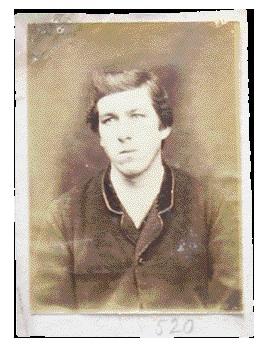
Laurence Lonergan, Kilmiler, Co. Tipperary, 1866–7 Fenian Photographs, class 28.
A glossary of frequently used terms or names of organisations, such as ‘conacre’, ‘rapparee’ and ‘Whiteboy’, has been provided. These have been extracted, with the kind permission of the Oxford University Press, from The Oxford Companion to Irish History, ed. Sean J. Connolly (Oxford, 1998), an invaluable aid to anyone studying Irish history.
The National Archives has been waiting for many years for appropriate accommodation. One of the results of inadequate premises is our lack of capacity in the area of education and outreach. While we facilitate groups who wish to visit us as much as possible, we have no lecture room or exhibition space, and even the small room we had for group workshops has now been swallowed up in expanded office space. We cannot even begin to consider taking school group visits, thus denying a large number of potential users access to our material. It is hoped that Counties in time will go some way towards addressing this deficiency.
The new Leaving Certificate history syllabus, to be introduced in September 2004, emphasises the use of primary sources, and teachers will need materials to assist them in this new challenge. Some of the documents included in Counties in time correspond to topics prescribed in the new syllabus—the Famine, the 1798 Rebellion and the War of Independence, among others. The National Archives intends to work in partnership with history teachers to supply further primary sources from our holdings to meet their needs in teaching this exciting new curriculum.
Many people cannot visit the National Archives because they live outside Dublin or are working during our opening hours. Counties in time will, hopefully, give them a detailed introduction to our most popular countrywide sources. Our archival heritage is hugely important for an understanding of our past; technology is now making it possible to widely disseminate records which have a great deal to tell us about that past. Counties in time is one contribution to this new and exciting information and knowledge revolution.
Catriona Crowe is General Editor of Counties in time and Senior Archivist, Special Projects, at the National Archives of Ireland.
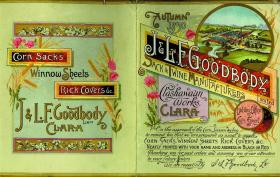
Colour advertisement for J. & L.F. Goodbody, jute manufacturers, Clara, King’s County, autumn 1890 Business Records, class 29.
Counties in time can be purchased for E26.75 (inc. p+p) from Eneclann, Unit 1b, Trinity College Enterprise Centre, Pearse Street, Dublin 2, Ireland, int+353-(0)1-6710338, www.eneclann.ie.
















